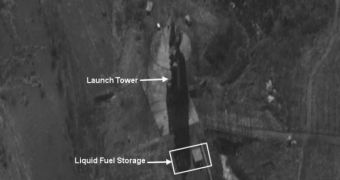Despite the fact that North Korea launched its redesigned Taepo-Dong-2 long-range missile on Sunday ignoring all warnings, the mission in itself was an utter failure, if its goal was to deliver a small communications satellite into orbit. The UN and the United States, together with Japan and South Korea, strongly opposed the launch, which the nations said would further threaten the delicate peace in the region. Minutes after the April 5th event, Japan forwarded an official protest note to the Security Council of the United Nations, as the rocket was fizzling over its territory.
The North Korean regime announced that the mission was a complete success and that the communications satellite had reached orbit, a claim that was proven invalid by US intelligence data. They showed that the three-stage delivery system failed about half-way in its 13-minute ascent, and that, although the first stage was successfully jettisoned, the second and the third collapsed in the middle of the Pacific Ocean.
In all fairness to the communist nation, this time, the country announced where the stages would fall, so that all ships and airplanes in the designated areas could be advised of the danger. This is more than they did the last two times when they launched similar vehicles.
The western world is preoccupied with the fact that North Korea is actually using its so-called space program in order to test Intercontinental Ballistic Missiles (ICBM), capable of reaching Alaska, Hawaii, and even deep within the continental United States. The entire Russian and Chinese territories are also within range, as are some parts of the Middle East. Japan is the largest opponent of the country's launches, while China has offered to “assist constructively” in mediating the crisis.
The Taepo-Dong-2 was, for the first time, used in 1998, when it also failed. However, at the time, the second stage was successfully separated, and it managed to reach the Japanese air space. It was at that moment that Japan really started taking things “personally,” and for good reason. After the failure, NK engineers heavily redesigned the prototype, and launched another rocket again in July 2006. It too failed, this time during the first stage ignition.
“Once they [North Korea[ are successful with a third stage they would have a missile that could reach the western US. This is very serious and so it is critical that this administration play keen attention to this test activity,” the Chairwoman of the House Homeland Security Subcommittee On Intelligence and Risk Assessment, Representative Jane Harmon, said in a recent NBC interview, as quoted by Space.

 14 DAY TRIAL //
14 DAY TRIAL //